#de montfort hall
Text

Miracle Aligner - De Montfort Hall, England [31-05-2016]
269 notes
·
View notes
Text
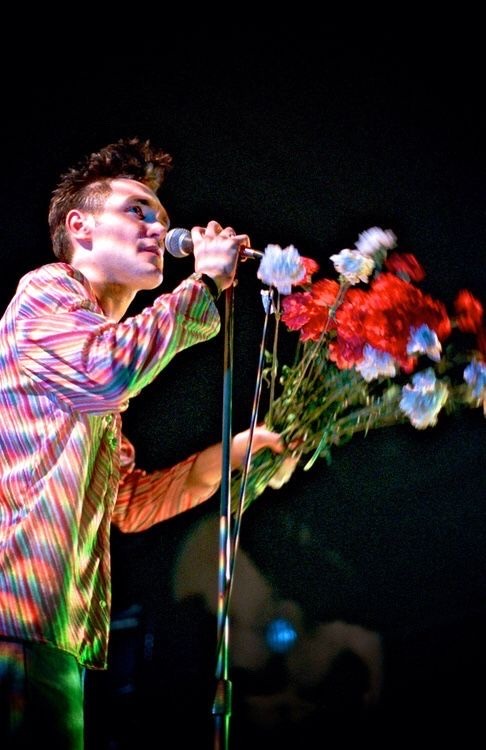

Steven Patrick Morrissey of ‘The Smiths’ on stage at De Montfort Hall (1984)
#steven patrick morrissey#morrissey#the smiths#celebs#aesthetic#lovecore#1984#80s#80s icons#de montfort hall#leicester#uk#united kingdom#bands#punk#music#music hall of fame
318 notes
·
View notes
Text

Mick Jones and Joe Strummer performing with at the De Montfort Hall , Leicester , UK , 16th January , 1980 .
©️ Kevin Cummins/Getty Images
#joe strummer#mick jones#the clash#punk boy#punk aesthetic#70s punk#80s punk#uk punk#punk rock#new wave#post punk#experimental rock#reggae#dub#funk#ska#rockabilly#the only band that matters#black and white photography#de montfort hall#leicester#uk#1980#kevin cummins#getty images
75 notes
·
View notes
Text
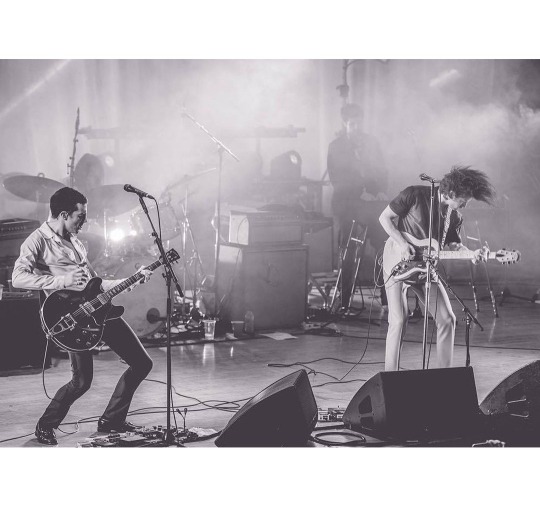

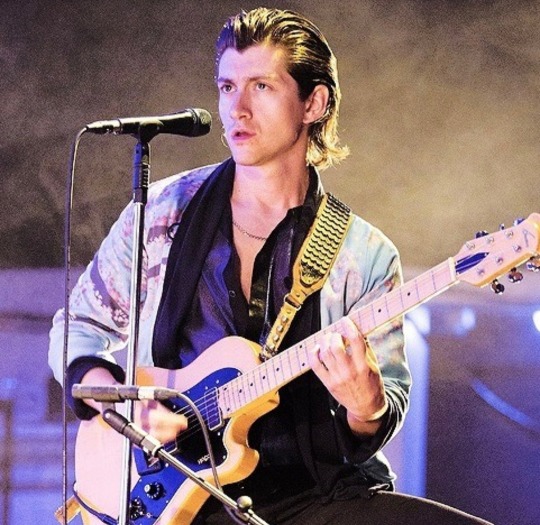
The Last Shadow Puppets - De Montfort Hall, Leicester
May 2016
📸: Olly Stabler and Andy Hughes
#the last shadow puppets#alex turner#miles kane#tlsp2#tlsp#eycte tour#eycte era#eycte#de montfort hall#leicester
63 notes
·
View notes
Text
Jarred Christmas 'Silly Billy' at De Montfort Hall
Jarred Christmas 'Silly Billy' at De Montfort Hall
Press tickets for review.
“An energetic show with giggles guaranteed from the fast-talking kiwi comedian”
“Have you ever even watched a comedy show before?”. If you hadn’t picked up, Alex was sceptical about whether I’d enjoy stand up comedy. What Alex had failed to remember was yes, yes I had! And it was with him!
Though, he was onto something. I’m not the biggest stand-up comedy fan. I have…

View On WordPress
0 notes
Text
Bollywood sensation, JUBIN NAUTIYAL, set to ignite the UK stage with his MAGICAL MELODIES TOUR
Bollywood’s chart-topping music maestro, Jubin Nautiyal, will be captivating the hearts of his UK fans once again on his highly anticipated 2024 tour, Magical Melodies. Known for his soul- stirring performances and mesmerising vocals, Nautiyal will grace the stages of iconic venues, OVO Arena, Wembley on 5th May; De Montfort Hall, Leicester on 6th May; and Bridgewater Hall, Manchester on 8th…

View On WordPress
#Bollwood#Bridgewater Hall#De Montfort Hall#Featured#Jubin Nautiyal#Leicester#London#Magical Melodies#Manchester#Music#OVO Arena#UK Tour#Wembley
0 notes
Text
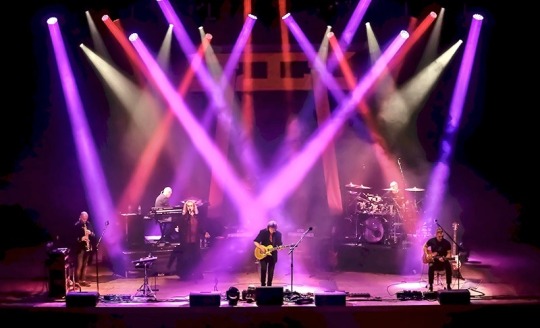
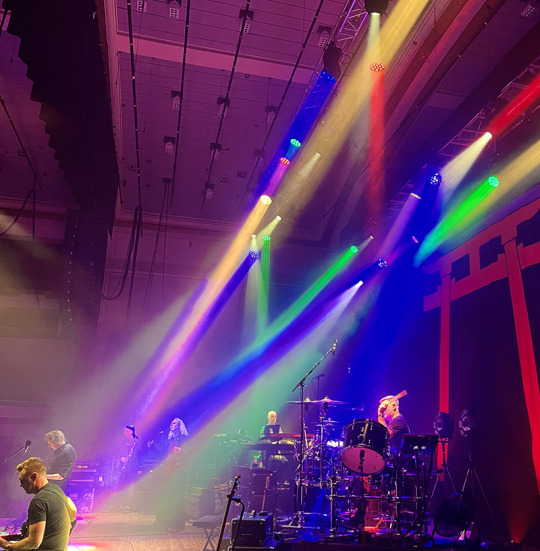

Already a week since I went to an amazing Steve Hackett gig at the Leicester De Montfort hall for his “Foxtrot at 50” tour, which celebrates 50 years since the release of the iconic Genesis album “Foxtrot”.
#steve hackett#genesis#foxtrot#foxtrotat50#Leicester De Montfort Hall#prog#prog rock#progressive rock#rock bands#rock. suicide#guitarist
4 notes
·
View notes
Text
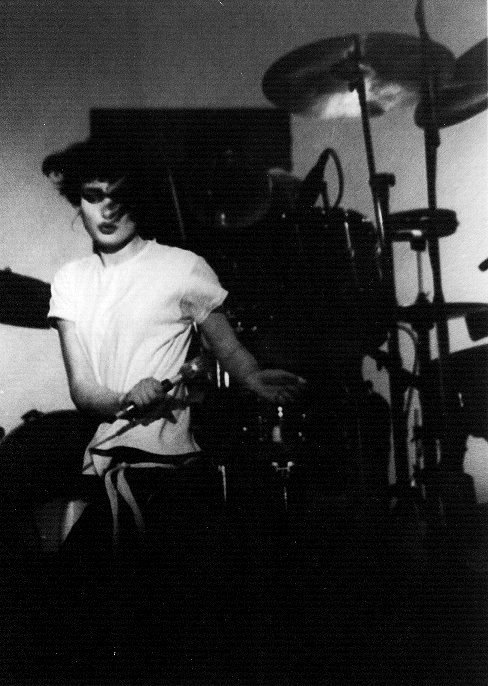

Siouxsie dancing during a gig with The Banshees at De Montfort Hall, Leicester, in 1980, as captured by Mike “Dawkeye” Dawkins.
(via & via)
555 notes
·
View notes
Text

RINGO STARR AND PAUL MCCARTNEY AT THE DE MONTFORT HALL LEICESTER BRITAIN - 1963
"I remember the moment, standing there and looking at John and then looking at George, and the look on our faces was like, 'Fuck you. What is this?'" said Paul McCartney, looking back on the Beatles' first time playing with Ringo Starr. "And that was the moment, that was the beginning, really, of the Beatles."
#beatlemania#ringo starr#paul mccartney#music story#history music#music#my music#music love#musica#rock music#pop#rock photography#rock#the beatles#s1963
33 notes
·
View notes
Text
The Horne section are touring next year!!!!
14 notes
·
View notes
Text
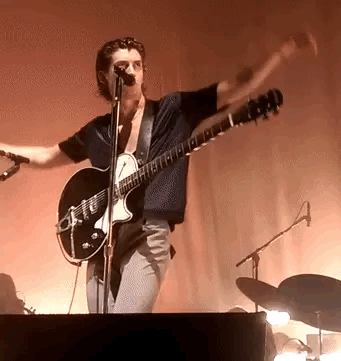
Miracle Aligner - De Montfort Hall, England [31-05-2016]
97 notes
·
View notes
Text
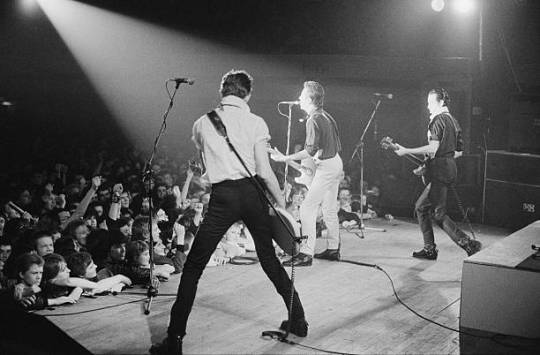
The Clash performing at the De Montfort Hall , Leicester , 16th January , 1980 .
©️ Kevin Cummins/Getty Images
#joe strummer#mick jones#paul simonon#topper headon#the clash#punk boy#punk aesthetic#70s punk#80s punk#uk punk#punk rock#new wave#post punk#experimental rock#reggae#dub#funk#ska#rockabilly#the only band that matters#black and white photography#de montfort hall#leicester#uk#1980#kevin cummins#getty images
30 notes
·
View notes
Text
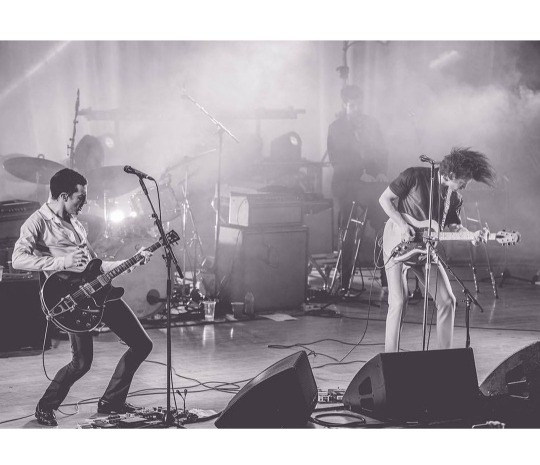
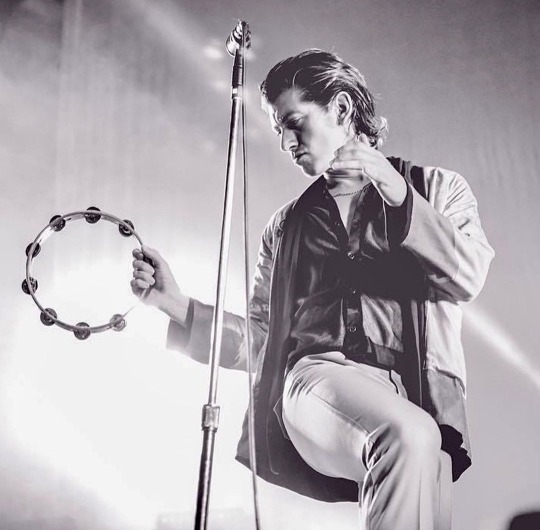
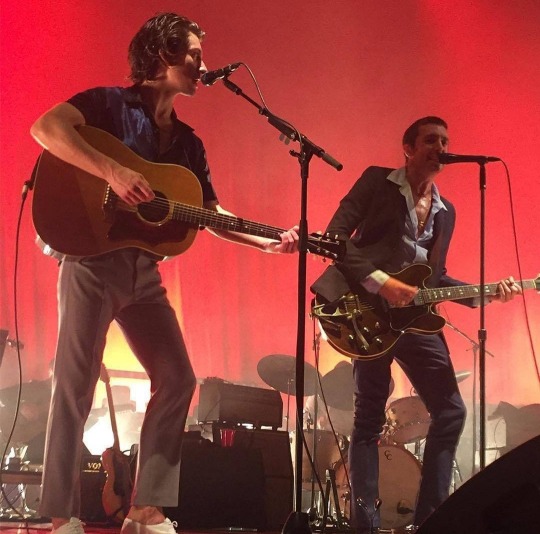

The Last Shadow Puppets - De Montfort Hall, Leicester
May 2016
📸: Olly Stabler and Andy Hughes
#the last shadow puppets#alex turner#miles kane#tlsp2#tlsp#eycte era#eycte#everything you've come to expect#De Montfort Hall#arctic monkeys
141 notes
·
View notes
Text


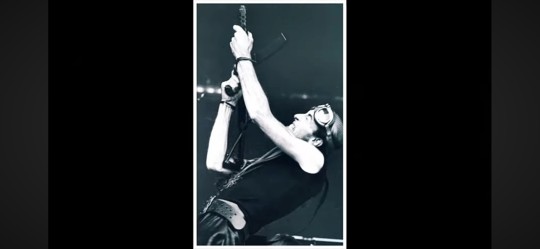
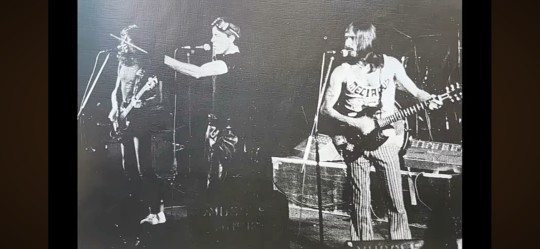

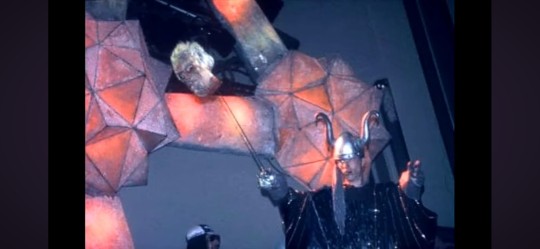

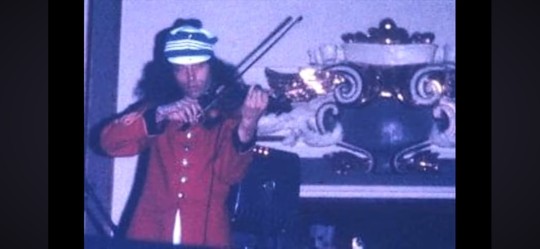
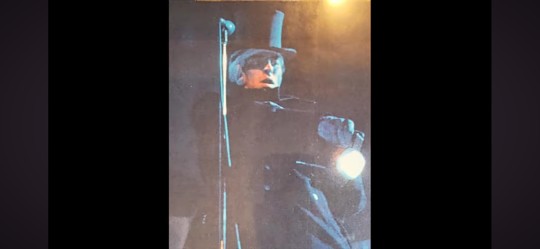
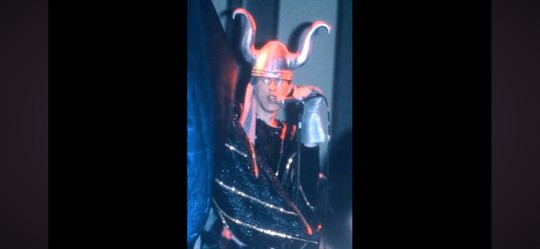
2 notes
·
View notes
Text
The Classic Rock Show at De Montfort Hall, Review
The Classic Rock Show at De Montfort Hall, Review
If you’re a die-hard fan of classic rock, The Classic Rock Show is a must-see. Tribute shows sometimes get a lot of stick, but this one pays homage to the classics and bring them to life in an electric night. Everybody will have a different impression of classic rock, so don’t worry if your favourite isn’t played this time, because they change the set-list every year! This tribute band takes you…

View On WordPress
0 notes
Text
Emerald Graves: Din'an Hanin

Din'an Hanin is a large elven ruin found in the southeastern region of Orlais, in Elgar’nan’s Bastion. It is the final resting place of the Emerald Knights. Since the end of the Exalted March of the Dales and the fall of elven Halamshiral, Din'an Hanin has remained abandoned and largely forgotten.
It’s important to notice this is not exactly an “ancient elvhen” ruin. It’s an Elvhenan building taken by Ancient Dalish and turned into a ruin after the Exalted March of the Dales. This is very important to highlight to understand the iconography we are going to see here.
[This is part of the series “Playing DA like an archaeologist”]

In my opinion, the clarification of the time in which Halamshiral shone is key to understand this ruin. This tomb will reflect exactly the same spirit that Ameridan showed in the Frostback Mountains, DLC of Jaws of Hakkon.

As we enter Din'an Hanin, we see a stair surrounded by the undeniable shape of elven buildings with statues: we find a broken Humanoid Mythal’s statue on the ground, and two howling Fen’Harel. Mythal statue triggers fragments of the codex The Emerald Knights. The first fragment we have here seems to be a warning to me: Curse the past where lies were born. There is also another detail in this fragment: they call Andraste as “Lady”. There is respect to her. If contemporary history is to be believed; we know she helped the Dalish to have these lands, so it seems reasonable for them to respect her.

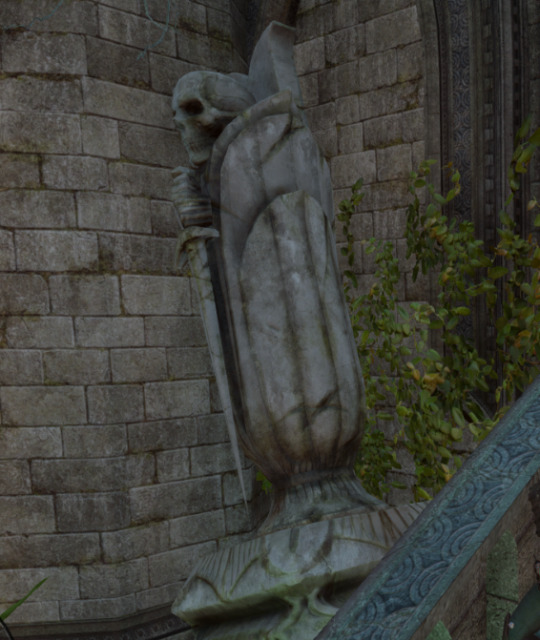
On the other side of the stair, we find one of the most strange statues to see in elven ruins: The cursed Skull bud with sword.
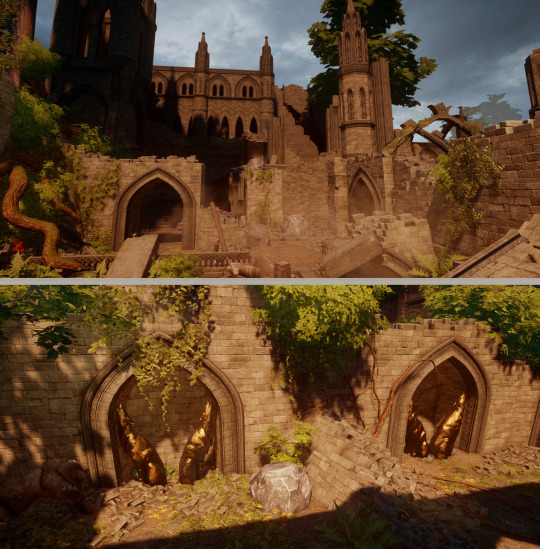
As we continue going ahead, we see more parts of the place that was attacked during the Exalted March, the rubble sinks deep enough in the terrain to assume it’s old destruction.
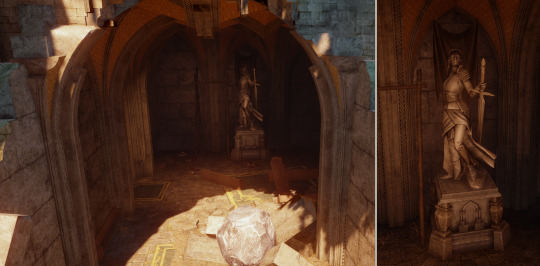
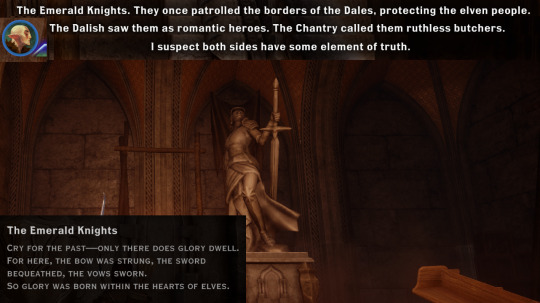
When we are reaching the entrance of the building, we meet another strange statue. We know with total certainty that these statues are Andraste, in her shape of a warrior. We have seen them everywhere in the game, and specially in Val Royeaux, triggering codices and notes about her. So, this is speaking to us that in a ruin of the time of Halamshiral, Andraste was honoured among the Dalish. She triggers another part of the codex The Emerald Knights.
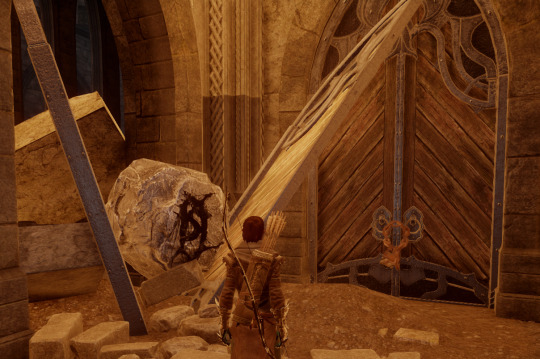
We see more attacks of those days, collapsing parts of the ruin and making it inaccessible. This rock is likely to be from an Orlesian attack.


In the Hall of the Knights, we see ceilings that speak of ancient elven ruins, and statues of Owls which triggers the codex of Arlathan: Part One, an unreliable tale of Gisharel. Curiously, there is another statue hidden among the shadows: The Strange Idol‘s face. It’s repeated in most of the arcs.
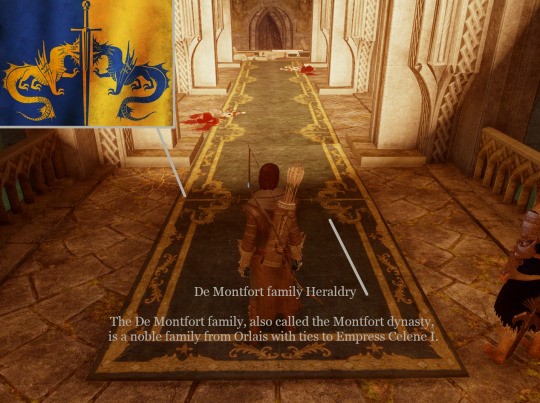
Continuing the path towards the tombs, we reach the corridor of the first floor, finding another strange element that speaks about how these elves were Dalish and not Elvhenan: the rugs in these parts display the symbol of the family of Celene’s mother: De Montfort.
This is very curious because this family begins to raise in prominence around the time of the Fourth Blight, while these Emerald Knights of the Exalted March were alive around the Second Blight. That this rug is here could mean that this place was explored before, or this family has very old ties with elves, specially during the time it was not an important family. With the context we were given about the Dales and the interracial examples of relationships, it’s not strange to assume that maybe this family is elf-blooded. But this goes into the speculation field. The only fact we see is that this rug with the De Montfort symbol is here, during a time [around the Second Blight] in which the family was not prominent.
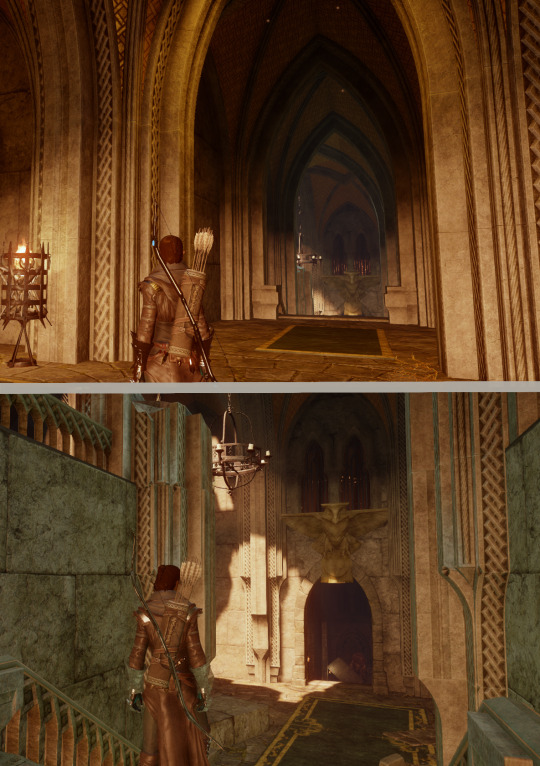
At the end of the corridor, we begin to walk downstairs to head into the tombs. We see the strong elements of the elvhen decorations and the Orlesian rug.

We make our way to the Hollowed Tombs. I think this name explains a bit the structure we will see inside. The entrance welcomes you with howling Fen’Harel statues at the sides.
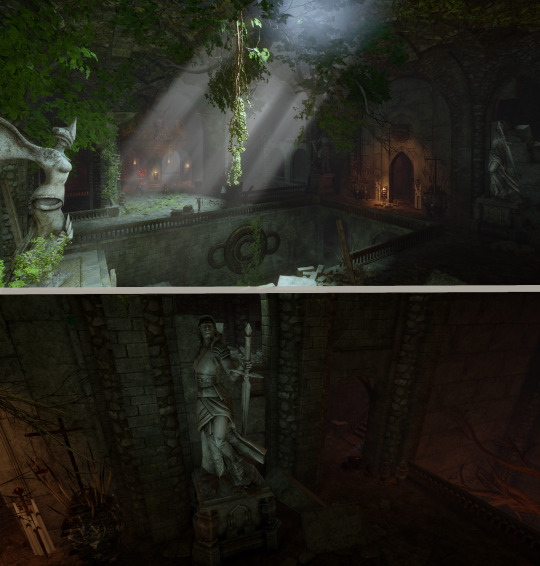
The place is already underground. It shows a mixture of Dalish, Elvhenan, and Chantry elements. Exactly the same kind of amalgamation of cultures we saw in Ameridan during the DLC Jaws of Hakkon. These elves were less radical with their culture as the current Dalish are, and they allowed the Chantry to permeate their elven temples to the point of placing statues of Andraste in them.
This brings a natural question: if they did this centuries ago, how much were their tales changed when they added Andrastian flavour in them? The culture that the modern Dalish want to preserve has been altered centuries ago by their own people too, not only Tevinter. The Dalish cultural process and attempts to recover their culture is an incredible tragedy and irony at the same time.
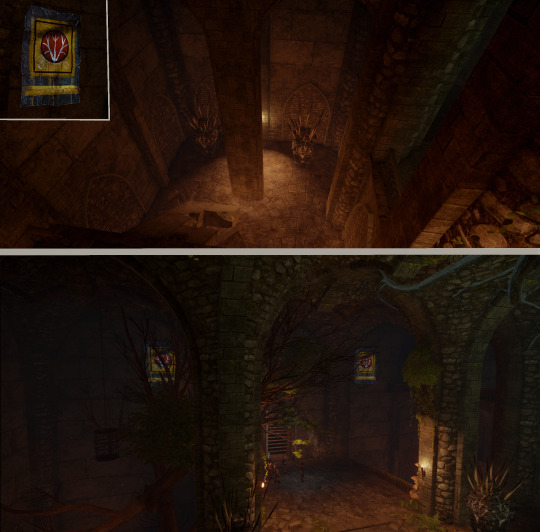
Going on with the exploration: at the sides of the entrance there are some pits interconnected with corridors. They show the inuksuit we always see related to funerary places. High up, close to the ceiling, we see Dalish banners.

This is the object that says this place of elvhenan origin has been taken by Dalish at some point.
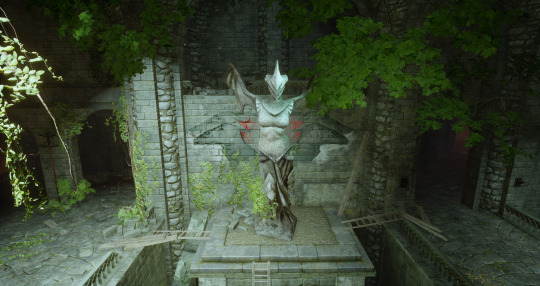
The central figure of this temple is Mythal, no doubt. The pit surrounds her, and her statue stands out among the others. Behind her, there is one of the typical paintings of ancient elves, this one I call “the shifting” halla or the bounded halla [for details read Nation Art: Elvhen].

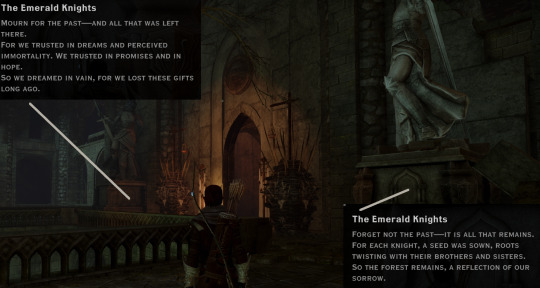
Exactly in front of this Mythal statue we find an entrance with the face of The Strange Idol on its top, flanked by two statues of Andraste that trigger more fragments of the codex The Emerald Knights. This entrance is blocked with rubble, but if you cross it with the fly cam and follow the path of the stairs, you reach exactly to the entrance of Elandrin’s tomb, where The Strange Idol is.


At the left side of the statue of Mythal, we find columns decorated with elven owls, and beyond them, a vandalised figure of Mythal. This is quite strange to me. It’s the statue of humanoid Mythal, with a skull on her head. The only detail I remember seeing in similar fashion in the series was in the Fade of DAO, where a statue of Andraste had her head replaced with a skull.
I can only find two potential reasons for this:
The ancient one: I imagine that so many iconography with broken statues of Dragon Mythal along the game, and this vandalism of her statue may be related to the hatred that she earned from the other Evanuris. We know that after all, she ended up being assassinated by them. And unlike the Temple of Mythal, where there are really few statues of broken Dragon Mythal, the rest of the elvhen ruins depict a lot her dragon figure without her head.

The modern one: maybe these Old Dalish elves related Andraste to a representation of Mythal, and her death [which happened before the complete fall of Halamshiral] was represented by them this way.
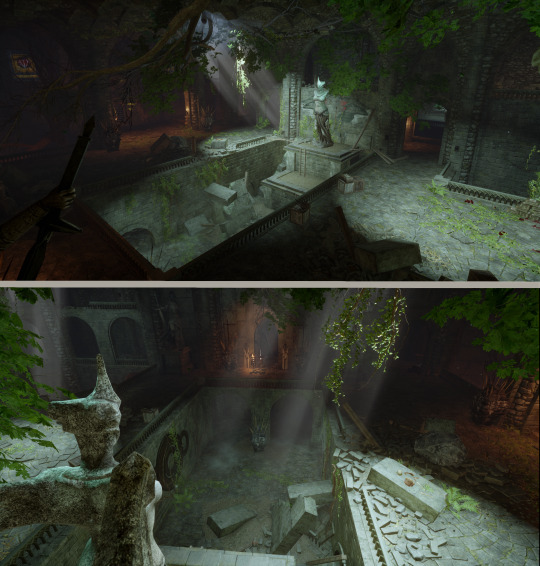
The configuration of this place is similar to the one we will see in Elandrin’s tomb: the main figure, [in this case Mythal] is in front of a pit. If the pit were filled with supplicants, they would be seeing her from a very low place. Unlike the Elandrin’s tomb, this pit doesn’t seem to have a system to raise the lower platforms. It must have been destroyed with the collapse of the place or simply it never had it.
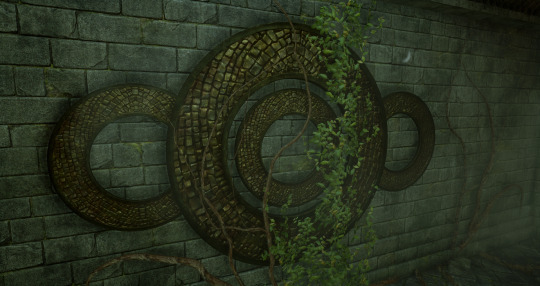
What’s most intriguing is the symbol on a side of one of the pit walls: these golden rings are Elvhenan. We saw them in the Shattered Library. The Elvhenan statue of the owl always has one of these on its talons.
In here, there are three rings of the same size, all aligned, and one bigger and thicker, surrounding and containing the middle one.
As potential links, we can have a quick reading of the many codices in the Shattered Library where concentric spheres are overlapped, or world in spheres are created. There is also a link with the red lyrium idol: the main figure has an arm crossing the same kind of ring than these. This figure has several links, specially if we take into account the murals of the series [For more details check: Red Lyrium Idol and Nation Art: Elvhen. It’s safe to assume that this is a symbol that belonged to the Elvhenan, and can’t be a representation of the creation of the Veil. When Solas created it, all the temples and tombs of the elvhenan had already been built, depicting this ring in their monuments or murals [More details in Nation Art: Elvhen].

If we explore the pit below and see what its corridors have to offer, we can see that at our left, the corridor is quickly blocked. It’s filled with funerary inuksuit...


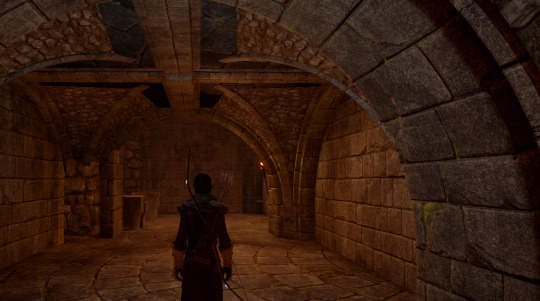
...while the corridor at our right side allows us to explore many other rooms. We see in these pits a lot of arcs that were filled with bricks before. When you destroy them, you have access to new rooms. This is curious, but given the name of this chamber [hollowed tombs], it seems to be a characteristic of this place: hollowed rooms are sealed with bricks containing mostly urns and/or special runes and veilfire messages of mourning.

Some of these pits have stairs that allow you to leave these corridors, but they have a strange feeling when you see the ancient paintings of slaved elves on its walls. If this is a tomb and we are right in assuming that Falon’Din was meant to guide the dead, but also this was a misunderstanding of his vanity that caused the death of many just for his whims, I wonder if these pits had an “elvhenan” function related to the slaves. What I mean is that maybe the Ancient Dalish used this ruin to give sepulchre to their warriors or honour Andraste, but this is an ancient elvhen ruin which must have had a different function long time ago.


Anyways, returning to the main statue of Mythal, we see the painting detail on the back, and if we see the rooms behind this wall, we find more elvhenan paintings and sealed rooms of dead. We see the painting of the dark armoured figure and breached walls [which I think it’s safe to assume it must have been the Venatori we find inside.] On a table, we see a book that triggers the Arlathan: Part Two, again an unreliable tale by Gisharel.

In the sealed rooms, we find dead, urns, paintings, and bones. Occasionally some of these structures trigger codices or notes about fallen Emerald Knights.

Sometimes these rooms are just locked but have no much difference with the others funerary rooms.

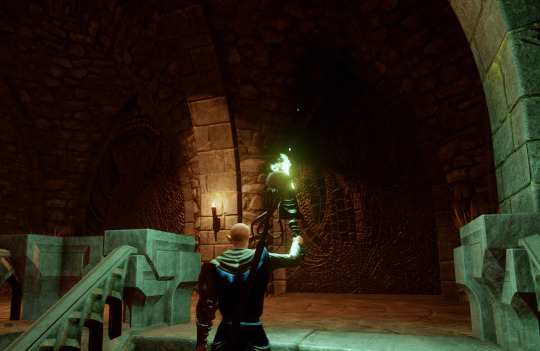
Close to the Andraste’s statues in the main chamber of Hollowed Tombs, there is a stair that allows you to reach the highest level of this tomb.

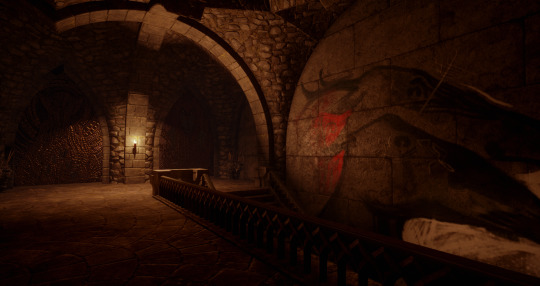
As we walk upstairs, we find the typical mosaics of the Evanuris: Dirthamen and Falon’Din, one beside the other, and a painting of a “shifted” / bounded halla along the stairs [Read The Lost Temple of Dirthamen - Part 1 to understand my supposition of how this halla could also represent “bounding process” specially when it is related to Dirthamen and Falon’Din].
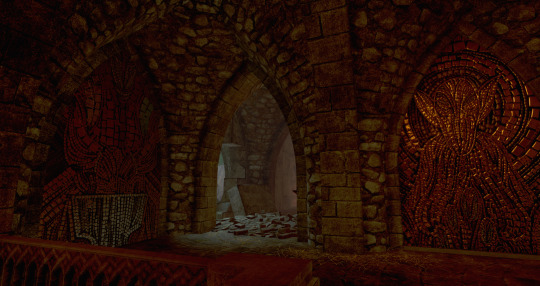
Around this place we find more mosaics: June with his anvil and Mythal with her babies.
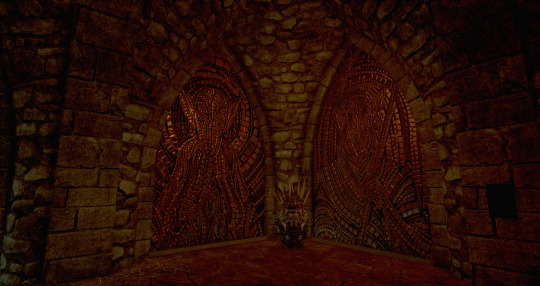
Mythal and Falon’din, which we know they had a confrontation [Solas’ words in the Temple of Mythal]. All these mosaics are normal ones in terms of colours [meaning, there is none red or weird so far I noticed].
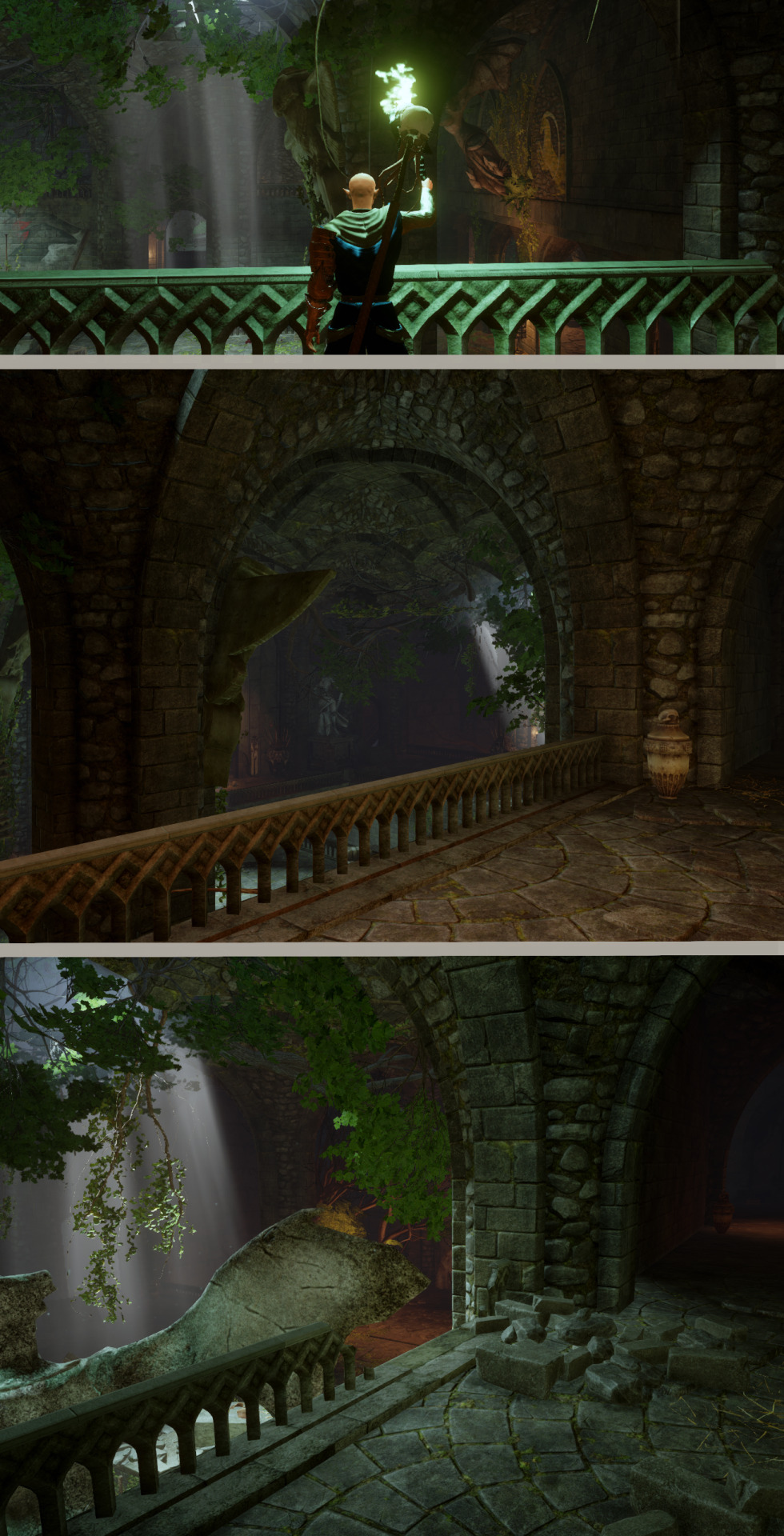
From the highest level, we can see the main statues and the pits. It gives the impression that this is a place where high priests could oversee all the rituals below, but since it has fences, it also seems to be a place for observation instead of imparting rituals. If we compare it with the Temple of Mythal, where the highest places were big, high stages for the priests to impart their blessing on the petitioners. This one here seems more like a mere overseer level.
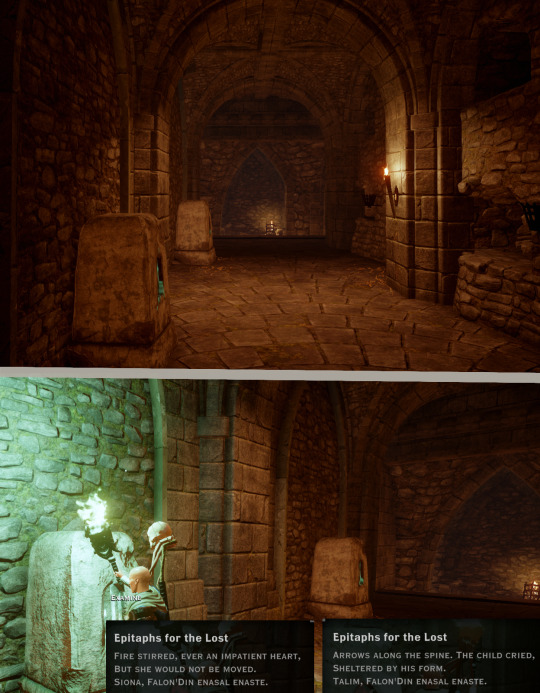
Along these corridors in the highest level we find more of these objects that trigger Dalish epitaphs.
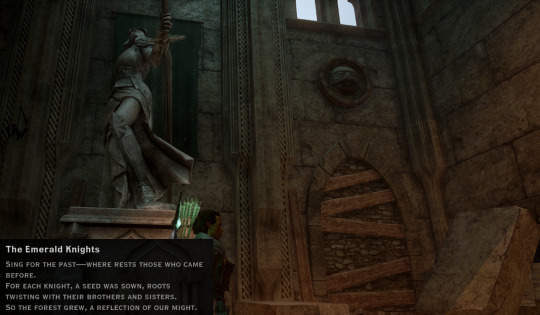
The last statue that triggers the final part of the codex is beside a corner that seemed to head to Elandrin’s tomb, as the face of the strange idol on the top may indicate. Once more, we see these entrances sealed, likely as part of the tradition: seal the rooms of the dead.
[Index page of Dragon Age Lore ]
#paintings#Howling Fen'Harel statue#Skull bud with sword#Humanoid Mythal statue#Elven Owl statue#The Strange Idol#De Montfort Symbol#Golden ring#inuksuit#Evanuris Mosaics#Andrastian design#dirthamen#Falon'Din#mythal#june#Playing DA like an archaeologist
22 notes
·
View notes